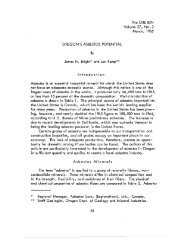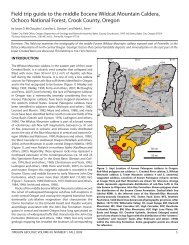Ore Bin / Oregon Geology magazine / journal - Oregon Department ...
Ore Bin / Oregon Geology magazine / journal - Oregon Department ...
Ore Bin / Oregon Geology magazine / journal - Oregon Department ...
Create successful ePaper yourself
Turn your PDF publications into a flip-book with our unique Google optimized e-Paper software.
Industrial minerals in <strong>Ore</strong>gon<br />
by Ronald P. Geitgey, <strong>Ore</strong>gon <strong>Department</strong> of <strong>Geology</strong> and Mineral Industries<br />
ABSTRACT<br />
A wide variety of industrial minerals is produced<br />
in <strong>Ore</strong>gon for regional, national, and<br />
international markets. The estimated total value<br />
of nonfuel mineral production in <strong>Ore</strong>gon in<br />
1988 was $169 million, virtually all of which<br />
was from industrial minerals. Sand, gravel, and<br />
crushed rock accounted for approximately $115<br />
million.<br />
Limestone is quarried from one location for<br />
cement production and sugar-beet processing<br />
and from two other locations for agricultural<br />
uses. Diatomite is produced by two companies,<br />
one for filter aids and the other for pet litter<br />
and oil absorbents. Bentonite clay from two<br />
operations is used primarily for civil-engineering<br />
applications, and structural clays are used<br />
by two brick manufacturers. Pumice from two<br />
areas is sold to concrete-block producers, and<br />
lesser· amounts are used for landscaping and<br />
for stone-washing certain garments. The zeolite<br />
mineral clinoptilolite is processed for absorbents<br />
and odor-control products. Exploration<br />
and limited production of perlite continues, and<br />
emery is produced for nonskid surface coatings.<br />
Quartzofeldspathic beach dunes supply material<br />
for container glass production, and quartz<br />
is quarried for nickel smelting, filter beds, poultry<br />
grit, and decorative uses. Talc, in the form<br />
of soapstone, has an international market as<br />
fine-quality art-carving material, and gemstone<br />
production includes agates, opal, obsidian, and<br />
suns tone, a calcic plagioclase feldspar.<br />
Many commodities produced in the past in<br />
<strong>Ore</strong>gon merit reevaluation. Some of these are<br />
brick clays, chromite, expandable shales,<br />
foundry sands, gypsum, iron-oxide pigments,<br />
peat, and building stone, including gray granites,<br />
white marble, black marble, sandstones,<br />
and volcanic tuffs. Production ceased for most<br />
of these because of market conditions and increased<br />
costs rather than product quality or deposit<br />
reserves.<br />
Several other commodities have the potential<br />
for new or increased production. Some have<br />
been evaluated; others are known occurrences<br />
that have geologic potential for commercial development.<br />
They include bentonite clay, borates,<br />
feldspar, ferruginous bauxite, fuller's<br />
earth, kaolin clay, nepheline syenite, perlite,<br />
and talc.<br />
INTRODUCTION<br />
Industrial, or nonmetallic, minerals are often<br />
unnoticed commodities, but their production<br />
is essential to nearly all phases of a modern<br />
economy, including construction, manufacturing,<br />
and production of food, fuels, and fibers.<br />
Their total value far exceeds that of the metals<br />
in both national and world markets.<br />
The term "industrial minerals" defies succinct,<br />
comprehensive definition. It encompasses<br />
natural rocks and minerals as well as<br />
manufactured products such as cement and<br />
lime. While often tern1ed "nonmetals", some<br />
industrial minerals are, in fact, metal ores that<br />
are utilized for properties other than their contained<br />
metal. Bauxite, for example, is the ore<br />
of aluminum metal but also the basis for some<br />
refractories (heat-resistant materials), abrasives,<br />
chemicals, and pharmaceuticals. Similarly,<br />
gemstones such as diamond and sapphire<br />
are included in some discussions of industrial<br />
minerals, in part because of their role as abrasives<br />
in the form of industrial diamonds and<br />
corundum. Perhaps it is simpler to say that<br />
industrial minerals are naturally occurring rocks<br />
and minerals and certain products manufactured<br />
from them that are not used as metal ores or<br />
as fuels.<br />
The uses of industrial minerals are highly<br />
diverse. Some are dependent on physical properties<br />
such as strength, hardness, softness, color,<br />
and density, while other uses, including chemicals,<br />
fertilizers, ceramics, and glass, are dependent<br />
on chemical composition. Hard or<br />
tough minerals such as quartz, gamet, or emery<br />
are used as abrasives and on wear-resistant surfaces.<br />
Soft minerals such as talc and graphite<br />
are valuable for their lubricity (slipperiness)<br />
and for the minimal wear they have on the<br />
equipment used to make products containing<br />
them. Strength, flexibility, and density are<br />
---I<br />
..iCoos.~<br />
>~8JLlCA !BAND<br />
'. <strong>Ore</strong>gon Industrial Mineral Producers<br />
(exclusive of aggregate and gemeton •• )<br />
I<br />
Klamath Fan. iBrlck & Tile<br />
• BRIe"<br />
I ,<br />
among several characteristics of plastics that<br />
depend on industrial-mineral content. In construction,<br />
industrial minerals are used as aggregates<br />
(sand, gravel, crushed rock), building<br />
stone, cement, plaster, and roofing materials.<br />
In paints, industrial minerals determine color,<br />
covering capacity, gloss, toughness, washability,<br />
and sag resistance. The paper industry uses<br />
numerous minerals as fillers and coaters to control<br />
various properties of the paper, such as<br />
bulk, weight, smoothness, opacity, and ink retention.<br />
Numerous juices, beverages, oils, and<br />
other liquids are filtered through layers or beds<br />
of certain industrial minerals to remove impurities<br />
and to clarify the product.<br />
Many industrial minerals can perform several<br />
different functions. For example, quartz<br />
in its several forms can be used in numerous<br />
applications, including glass, electronics, refractories,<br />
abrasives, aggregates, fillers, filters,<br />
and foundry sands. Limestone may be used<br />
for cement, aggregate, building stone, chemicals,<br />
glass, plastics, paper, agriculture applications,<br />
sugar refining, and treatment of waste<br />
liquids and gases.<br />
As a result of this diversity of uses and<br />
properties, exploration for and evaluation of<br />
industrial minerals are often highly specialized<br />
fields. A chemical assay may be useful, but<br />
often physical properties, type of impurities,<br />
and distance from potential markets are far more<br />
important. In some applications, the precise<br />
Figure J. Current producers of industrial minerals in <strong>Ore</strong>gon.<br />
~~<br />
\ I.<br />
'i'I<br />
All<br />
;<br />
f<br />
r<br />
/<br />
OREGON GEOLOGY, VOLUME 51, NUMBER 6, NOVEMBER 1989 123

















